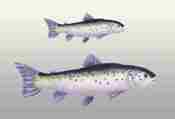Nofima studies effect of vaccines in Atlantic salmon

New vaccine trials show that Atlantic salmon develop fewer injuries and achieve higher growth rates with reduced vaccine doses as opposed to full vaccine doses. The amount of active ingredient is the same.
Project Manager Bjarne Gjerde and Research Fellow Tale Marie Drangsholt from Nofima Marin are among the scientists who made these finds in a project designed primarily to study whether the degree of side-effects resulting from the vaccination of Atlantic salmon is hereditary.
The collaborative project, which also involves the Norwegian School of Veterinary Science, Pharmaq AS and SalmoBreed AS, has trialled a new type of vaccine (test vaccine) against a traditional six-component vaccine (reference vaccine). The new test vaccine contained the same amounts of antigen as the reference vaccine, but was administered with an injection volume of 0.05 ml per fish compared to 0.1 ml for the reference vaccine.
Positive results
When the experimental fish were slaughtered after six months in sea cages at a weight of around one kilo, the fish that had received the test vaccine weighed around 8 % more than those that had received the reference vaccine. These fish also had a significantly lower degree of vaccine injuries, including fewer adhesions in the abdominal cavity, less pigmented melanin in the inner organs and less melanin on the abdominal wall.
Next step
For several generations, breeding programmes have been designed to increase resistance to furunculosis, ILA and IPN. However, the salmon are still vaccinated against these diseases, and little research has been carried out on how the combination of selective breeding and vaccination influence each other. Consequently, Drangsholt has commenced a project to study whether the families of salmon that were tested had different degrees of vaccine injuries. She will also study whether this is connected to the survival rate of unvaccinated siblings in challenge tests against furunculosis, one of the diseases that the vaccine is designed to protect against. This will confirm whether there is a connection between vaccine-related side effects and protection achieved through the breeding programmes.
Related website:
Nofima











